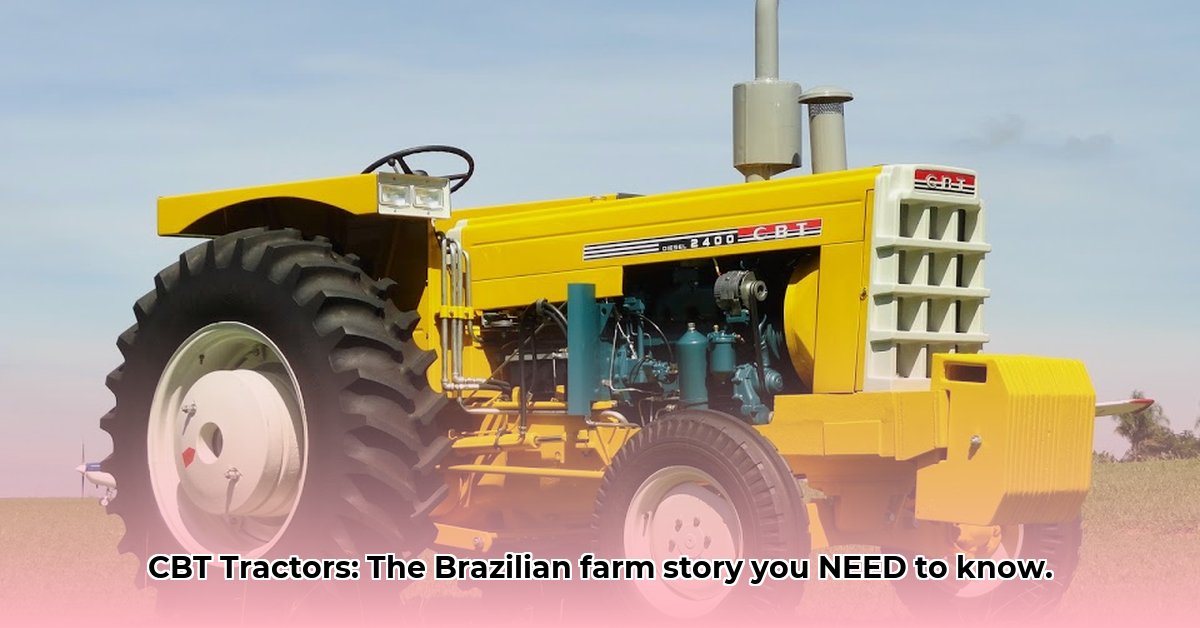
The Rise and Fall of a Brazilian Agricultural Giant
The story of Companhia Brasileira de Tratores (CBT Tractors) serves as a compelling case study in the complexities of industrial development, government policy, and the challenges of global competition within the dynamic context of Brazilian agriculture. From its inception in 1959 until its closure in 1995, CBT's trajectory, marked by initial dominance and eventual collapse, offers invaluable insights for businesses and policymakers alike. How did a company that once held a significant share of the Brazilian tractor market succumb to international competition? Understanding this requires a detailed analysis of its rise, its fall, and the broader economic and political landscape in which it operated. For more on global tractor markets, see this resource.
The Rise of CBT: A Protected Market
CBT's initial success can be largely attributed to a protected domestic market. Government policies, designed to foster domestic industrial growth, shielded CBT from foreign competition, allowing it to establish a strong foothold and capture significant market share. By initially importing and rebadging Oliver tractors, CBT gained valuable experience and market access, leveraging this foundation to subsequently develop its own line of tractors tailored to the specific requirements of Brazilian agriculture. These tractors, using engines from various suppliers including Perkins, Mercedes, and MWM, offered a range of power options catering to diverse farming needs (1-310 horsepower). The company’s domestic dominance was therefore not merely a result of government support but also a strategy of adaptation and market penetration. This initial success, however, proved to be a double-edged sword. Did this success breed complacency, hindering the long-term adaptability essential for survival in a globalized marketplace?
The Gathering Storm: Market Liberalization and Global Competition
The early 1990s marked a turning point. Brazil's embrace of market liberalization, involving the removal of trade barriers such as tariffs and quotas, exposed CBT to intense competition from established international players. These competitors possessed superior technology, well-established international supply chains, and economies of scale significantly exceeding CBT's capabilities. CBT’s previously successful strategy, honed under protectionist policies, was suddenly inadequate. The company struggled to compete on price and innovation, highlighting the critical impact of market dynamics on industrial survival. How did the speed of market opening contribute to CBT's demise? Was a more gradual transition possible, allowing for a smoother adaptation?
The Fall of CBT: A Lack of Innovation and Adaptability
CBT’s inability to adapt to this new competitive landscape resulted in its ultimate demise. A lack of investment in research and development left its tractors technologically inferior to those of its global competitors. The company failed to innovate and improve its products, unable to keep pace with the advancements offered by international manufacturers. This failure to adapt, coupled with the loss of protective measures, proved fatal. Was the lack of investment a consequence of internal management decisions, or a reflection of broader challenges in securing funding for R&D within a rapidly changing market? This question remains a crucial area for further research.
Lessons Learned: A Post-Mortem Analysis
The collapse of CBT Tractors offers crucial lessons for the Brazilian agricultural sector and beyond. Beyond the immediate impact of market liberalization, we can identify several critical factors.
The limitations of protectionism: While initially beneficial, over-reliance on government protection can stifle innovation and prevent the development of long-term global competitiveness. The sudden removal of protective measures exposed CBT's vulnerabilities.
The critical role of R&D: Continuous investment in research and development is crucial for sustained success in a globally competitive market. CBT's failure to innovate led directly to its technological inferiority.
The importance of adaptability: Businesses must develop agile and flexible business models capable of responding to shifts in market dynamics, technological advancements, and policy changes.
Need for balanced government policies: Government policies should aim to foster both domestic industry growth and prepare businesses for successful competition in global markets; a balanced approach is necessary to avoid the pitfalls of excessive protectionism.
A Roadmap for the Future of Brazilian Agriculture
What can Brazil learn from the experience of CBT? The key takeaways translate into several vital strategic components:
Prioritize R&D: Continued and substantial investment is crucial to ensure Brazilian agricultural equipment manufacturers can develop technologically advanced, competitive products.
Foster Innovation: An environment that nurtures innovation, encourages risk-taking, and supports collaboration between industry and academia is vital.
Strategic Alliances: Collaboration with international players can offer access to technology, expertise, and efficient supply chains, thereby mitigating risk and accelerating innovation.
Sustainable Business Models: Adaptable and resilient business models are essential in navigating the dynamic global agri-business environment.
The closure of CBT Tractors serves as a powerful case study illustrating the interplay of government policy, innovation, and global competition in shaping the success or failure of businesses. Understanding the complexities of its demise is crucial to shaping a more resilient and successful future for Brazilian agriculture. Further research into the internal management decisions and specific financial challenges faced by CBT would further enrich this analysis.